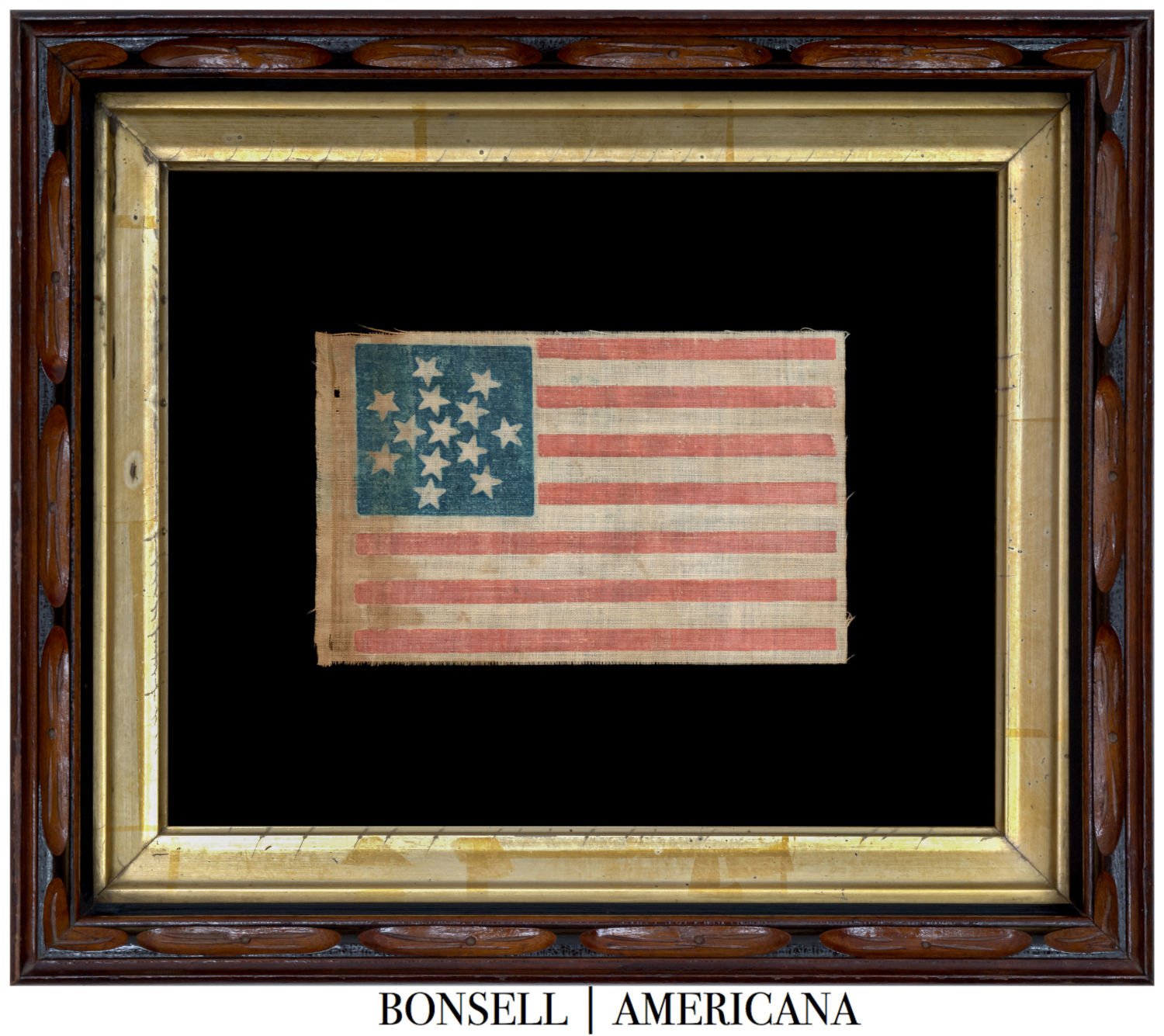Highly Attractive 29 Star Antique Flag with a Medallion Star Pattern | A Classic American Parade Flag | Iowa Statehood | Circa 1846-1848
Highly Attractive 29 Star Antique Flag with a Medallion Star Pattern | A Classic American Parade Flag | Iowa Statehood | Circa 1846-1848
Frame Size (H x L): 12” x 16”
Flag Size (H x L): 7” x 10.75”
Offered is a twenty-nine star flag, printed on glazed cotton. Its stars are arranged in a medallion pattern. The large star in the middle is referred to as a “center star,” and it is canted to the 11:00 position. The center star represents the newest state added to the Union. In the case of this twenty-nine star flag, it represents Iowa. Surrounding the center star is a pair of concentric rings of stars, and surrounding the rings are four flanking stars positioned in the corners of the canton.
The stars of this flag are pointy and folksy in their appearance, and are tightly packed onto the canton. Although the maker of this flag is unknown, these distinctly shaped stars are common to a small family of flags that originated from the same workshop. The maker of this flag made six star counts in this same style: seven, thirteen, fifteen, twenty-nine, thirty-three, and thirty-five. The seven star flags were made to celebrate the first seven states to secede from the Union, while the thirteen star flags were made to celebrate the original thirteen states. The fifteen star flags were made to celebrate Kentucky’s centennial. And the twenty-nine, thirty-three, and thirty-five star flags were made to celebrate the latest states added to the Union. The twenty-nine star variation is the oldest flag produced by this maker, and they rarely surface.
IOWA STATEHOOD
Iowa’s journey to statehood began in the early nineteenth century, as settlers moved westward and established communities within the Iowa Territory. Originally part of the Louisiana Purchase, Iowa was officially organized as a territory in 1838, a period marked by rapid population growth and increasing political organization among its residents. These settlers were drawn by fertile farmland and the promise of new opportunities, and their burgeoning communities began pushing for greater self-governance and representation within the U.S.. Following a series of debates about Iowa’s borders, which were influenced by regional and economic interests, Congress approved Iowa's admission as a free state, reflecting the nation's balance of power between free and slave states during a period of sectional tension.
On December 28th, 1846, Iowa was formally admitted to the Union, becoming the twenty-ninth state. This event was soon commemorated by a new American flag with twenty-nine stars, symbolizing Iowa's place within the nation. The flag, adopted on July 4th, 1847, stood as an emblem of unity during a time when the expansion of U.S. territories and states shaped the country's identity and tested its cohesion. This star-spangled banner remained official for one year, during which Iowa’s early statehood was characterized by its focus on agriculture, infrastructure, and defining its role within the Union.
By July 4th, 1848, a thirtieth star was added to the flag to include Wisconsin, marking a swift pace of statehood admissions that characterized mid-nineteenth century America. Iowa's inclusion marked not only an expansion of the Union but also a shift in the nation's demographic and political landscape as more western territories sought statehood. Iowa's entry into the Union and the brief lifespan of the twenty-nine star flag underscore the dynamic period of American expansion and development, during which the U.S. continued to grow and transform toward a unified, coast-to-coast nation.
RARITY
Twenty-nine star flags are extremely rare for two reasons. First, they were only official for one year, so flag makers dedicated a short manufacturing window to their production. And second, they are pre-Civil War flags. Generally speaking, flags predating the Civil War time period (1861-1865) are the rarest and most desirable of all US flags. Prior to the Civil War, Americans did not typically display flags for patriotic purposes. And, likewise, the military did not regularly use the flag, as it was not until 1834 that the army field artillery was permitted to carry the traditional US flag, and it was not until 1841 that regiments carried it. For these reasons, flags made prior to the Civil War account for only around 1-in-100 flags made in the 19th century.
Conservation Process: This flag was hand sewn to cotton fabric, and both were hand sewn to a mounting board. To prevent the black dye in the cotton fabric from seeping into the flag, it was first washed in a standard wash and then in a dye setting wash. The flag is positioned behind Optium Museum Acrylic.
Frame: This frame is a beautifully preserved example of a "blocks-in-corner" Hicks style, crafted in mahogany with a veneer finish, dating back to the 1829-1835 period. The blocks-in-corner design is distinctive, showcasing a refined and symmetrical look that complements the flag.
Condition Report: Remarkable condition, particularly for its age, with vibrant colors and minimal wear. While there is some yellowing, it does not distract from the flag's overall presentation.
Collectability Level: The Best – Perfect for Advanced Collectors
Date of Origin: 1846-1848
Number of Stars: 29
Associated State: Iowa








